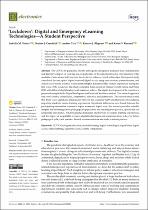‘Lockdown’: Digital and emergency elearning technologies—A student perspective
| dc.contributor.author | Venter, Isabella M. | |
| dc.contributor.author | Cranfield, Desirée J. | |
| dc.contributor.author | Blignaut, Renette J. | |
| dc.date.accessioned | 2022-10-05T10:12:20Z | |
| dc.date.available | 2022-10-05T10:12:20Z | |
| dc.date.issued | 2022 | |
| dc.identifier.citation | Venter, I. M. et al. (2022). ‘Lockdown’: Digital and emergency elearning technologies—A student perspective. Electronics (Switzerland) , 11(18), 2941. https://doi.org/10.3390/electronics11182941 | en_US |
| dc.identifier.issn | 2079-9292 | |
| dc.identifier.uri | https://doi.org/10.3390/electronics11182941 | |
| dc.identifier.uri | http://hdl.handle.net/10566/8019 | |
| dc.description.abstract | The COVID-19 pandemic and the subsequent emergency measures had a fundamental and disruptive impact on societies and, in particular, on the educational sector. The transition of the modality of educational delivery from face-to-face to online occurred within days; this research study considered the concepts of digital trust and digital access, using structuration, postmodernism, and critical social theory as lenses to understand Higher Education (HE) student experiences during the first wave of the lockdown. The study compared these aspects in Hungary, South Africa, and Wales (UK) with different digital and network readiness indices. The digital development of the countries is presented using both the Digital Intelligence and Network Readiness indices. The research approach was cross-country, international, comparative, inductive, and quantitative. | en_US |
| dc.language.iso | en | en_US |
| dc.publisher | MDPI | en_US |
| dc.subject | Covid-19 | en_US |
| dc.subject | Higher education | en_US |
| dc.subject | Online learning | en_US |
| dc.subject | Digital technologies | en_US |
| dc.subject | South Africa | en_US |
| dc.title | ‘Lockdown’: Digital and emergency elearning technologies—A student perspective | en_US |
| dc.type | Article | en_US |

